





ECUADOR
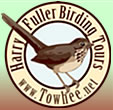
Ecuador, Part I
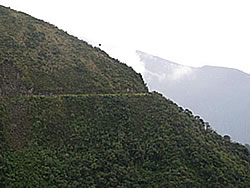
Day One, began before dawn... and we drove up to the base of the Yanacoche Trail west of Quito, on the lower slopes of the Cotocachi Volcano. Here's a look (right) at the trail that confronted us after the sun rose. Level walking, but steep slopes on either sides. True cloud forest above 11,000 feet.
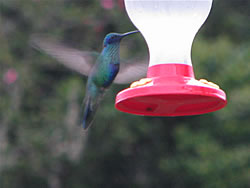
And there were hummingbird feeders at a few points along the trail, so naturally there were pictures to be taken and here's my first lifer photo in Ecuador (left): Green Violet-ear, my first of many Ecuadorian hummers, where they have as many species of hummingbirds as any nation in the Neotropics. Those unfortunate birders in Eurasia and Africa have ZERO hummers, of course.
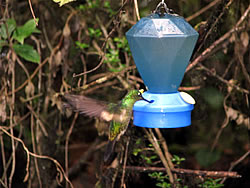
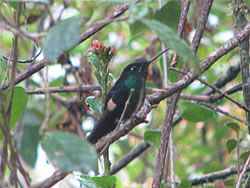
Buff-winged Starfront (above), an abundant and aggressive presence along the Yanacoche. One of the forty-four species of hummingbird we saw in Ecuador, less than half of the total possible in that country. But 44 is more than anybody will ever see in a lifetime of birding North America, let alone in nine days.
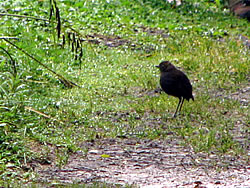 And then a close encounter with a young bird who proceeded to walk ahead of us on the trail. A juvenile Chestnut-naped Antpitta (right and below), about ten inches tall and high -hipped with spindly legs and an upright hustle. The bird never did fly but ambled off into the brush along the trail when we finally pushed past him, or her. Antpittas are in a family of birds found only in the Neotropics. Latin family name: THAMNOPHILAE, antbirds who specialize on ground insects. Important family in a climate where insects can and do breed and multiply year-round. Family includes antshrikes, antwrens, antbirds, antthrushes. Most are skulkers and very hard to see. This callow fellow did NOT set a pattern for the week and our guide often spent long periods trying to coax a calling antbird into view, usually low in dense bamboo or other underbrush.
And then a close encounter with a young bird who proceeded to walk ahead of us on the trail. A juvenile Chestnut-naped Antpitta (right and below), about ten inches tall and high -hipped with spindly legs and an upright hustle. The bird never did fly but ambled off into the brush along the trail when we finally pushed past him, or her. Antpittas are in a family of birds found only in the Neotropics. Latin family name: THAMNOPHILAE, antbirds who specialize on ground insects. Important family in a climate where insects can and do breed and multiply year-round. Family includes antshrikes, antwrens, antbirds, antthrushes. Most are skulkers and very hard to see. This callow fellow did NOT set a pattern for the week and our guide often spent long periods trying to coax a calling antbird into view, usually low in dense bamboo or other underbrush.
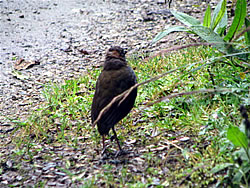
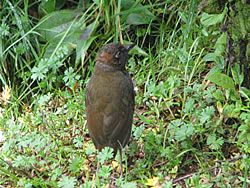
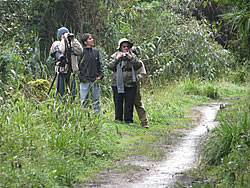
And who
else was watching this fearless antpitta? Another small group of
birders that included old birding friends, Mr. and Mrs. Contreras
from San Francisco. So we'd unknowingly come three thousand miles
to share the Yanacoche and a young Antpitta's parade.
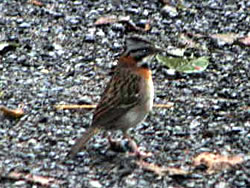
An adult Rufous-collared Sparrow (right), member of the venerable Zonotrichia clan. Thus a near-cousin of the Golden-Crowned and
White-crowned Sparrows of the Pacific Coast and the White-throated
Sparrows of eastern U.S. Large and abundant wherever there was
more grass than shade in mid-elevation Ecuador, a familiar parking
lot bird.
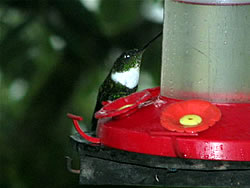
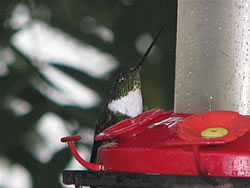
At several of our Ecuador birding stops there were myriad feeders, and above 6000 feet, one or more Collared Inca often made an appearance. And each male seemed to be calmer than most other species, more willing to sit long minutes at the bar, slowly quaffing the drink that was being served. So there he is (above), the Collared Inca male, five inches of splendor and life force. A velvety black set off by the pure white collar. Then in the right light, from the proper angle, a flash of bold color. Any couture designer would be in awe.
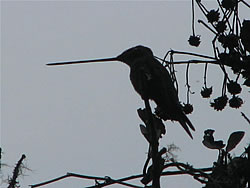
Check that profile, folks (right).
Here we have the Cyranose of hummingbirds. Not since De Bergerac
has such a schnozz been so poetic. And as with the theatrical
Cyrano, sword-play is involved. In this case the name is " Swordbill." Or more properly Sword-billed Hummingbird, Ensifera
ensifera. With a nose like that he gets a genus of his own. Be
patient, I will eventually get better pictures. Just Day One.
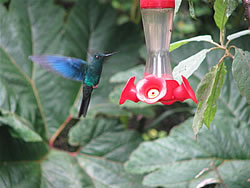
The Great Sapphirewing (left) caused oohs and aaaahs as he first zipped
into view and began to shimmer through the mist. He didn't need
sunlight, he was radiantly-coated in glowing colors. He probably
shines in the dark as well.
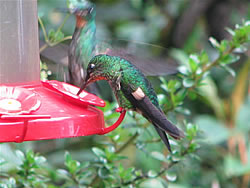 One better pic of the Buff-winged Starfrontlet (right). Other birds we spotted as we headed toward Bella Vista Lodge
uphill from Tandayapa Valley included: some of our first mountain-
tanagers, both Hooded and Black-chested... Spectacled Whitestart, a
boldly colored warbler... three species of Flowerpiercer, including
the omnipresent Masked Flowerpiercer... Blue-and-white Swallows at
the very roadside where this picture was taken... Barred Fruiteater... and the noise echoing across a steep ravine from the Andean Cock-of-the-Rock which we then watched fluttering about a lek site.
One better pic of the Buff-winged Starfrontlet (right). Other birds we spotted as we headed toward Bella Vista Lodge
uphill from Tandayapa Valley included: some of our first mountain-
tanagers, both Hooded and Black-chested... Spectacled Whitestart, a
boldly colored warbler... three species of Flowerpiercer, including
the omnipresent Masked Flowerpiercer... Blue-and-white Swallows at
the very roadside where this picture was taken... Barred Fruiteater... and the noise echoing across a steep ravine from the Andean Cock-of-the-Rock which we then watched fluttering about a lek site.
The humidity is such that you look across great canyons to green hillsides and it is not clear whether the moisture is falling from the sky, or rising from the earth. Perhaps both.
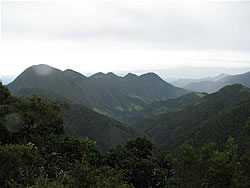
TOWHEE.NET: Harry Fuller, 820 NW 19th Street, McMinnville, OR 97128
website@towhee.net